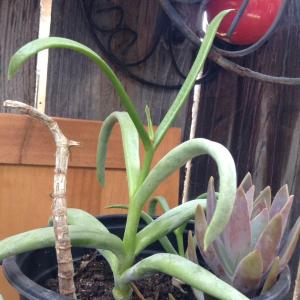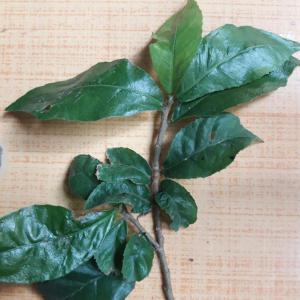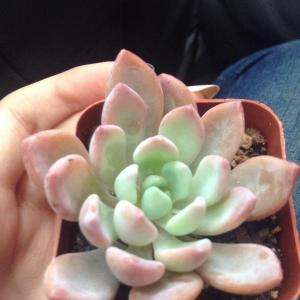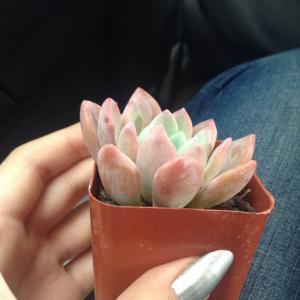成长记
meriunkat
2017年09月05日

I can't wait to see how it will look when it has grown longer, i wonder if this plant blooms..




1
0
成长记
Aria
2017年09月04日

I new added a "Graptopetalum Paraguayense 'Ghost Plant' Variegata" in my "garden"


0
0
成长记
Emi Cheshire
2017年09月04日

Krypto seems to be getting slowly better each day, working on getting plant fertilizer to help boost him a little!


0
0
Kierston Charles
2017年09月03日

my first air plant😍 added him to my collection 2 weeks ago and I love it!! #airlife #plantlife


0
0
文章
Dummer. ゛☀
2017年09月03日

The Canary Island date palm (Phoenix canariensis) is a beautiful tree, native to the warm Canary Islands. You can consider planting a Canary Island date palm outdoors in U.S. Department of Agriculture plant hardiness zones 9 through 11, or indoors in a container anywhere. With its shiny, feathery fronds, arching branches and ornamental fruit, this tree is not of the low-maintenance school. You’ll want to read up on care of Canary Island palm trees to be sure the plant stays healthy and happy.
Information on Canary Date Palms
If you are dreaming of Canary palm trees growing in your backyard, you’ll need lots of room. Information on Canary date palms lists these trees as growing up to 65 feet tall with a potential spread of 40 feet. However, planting a Canary Island date palm is not entirely out of the question if you have a small backyard. Canary palm trees growing speed is slow, and your specimen will only get to 10 feet tall during its first 15 years in the backyard. Other information on Canary date palms notes the long leaves of the species – from 8 to 20 feet long – and the extremely sharp spines at the frond base. The trunk can grow to 4 feet in diameter. Small white or gray blossoms produce showy ornamental date-like fruits in the summer.
Care of Canary Island Palm Trees
Planting a Canary Island date palm requires a full sun location and plenty of irrigation when the palm is young. As far as Canary palm tree care, think about providing water every week to help the plant establish deep roots. Once the tree is mature, you can reduce irrigation. Canary palm tree care includes feeding the tree. You’ll want to fertilize it every spring just before new growth appears. These trees need high levels of potassium and magnesium as part of Canary palm tree care. They can easily come down with deficiencies of these nutrients under landscape conditions. You’ll identify potassium deficiency by the pale color or spotting of the oldest fronds. As the deficiency progresses, the frond tips get brown and brittle.
Your tree has a magnesium deficiency if you see lemon yellow bands along the outer margins of older leaves. Sometimes, the trees have both potassium and magnesium deficiencies at the same time. Fortunately, the palm usually has few disease or pest issues.

Information on Canary Date Palms
If you are dreaming of Canary palm trees growing in your backyard, you’ll need lots of room. Information on Canary date palms lists these trees as growing up to 65 feet tall with a potential spread of 40 feet. However, planting a Canary Island date palm is not entirely out of the question if you have a small backyard. Canary palm trees growing speed is slow, and your specimen will only get to 10 feet tall during its first 15 years in the backyard. Other information on Canary date palms notes the long leaves of the species – from 8 to 20 feet long – and the extremely sharp spines at the frond base. The trunk can grow to 4 feet in diameter. Small white or gray blossoms produce showy ornamental date-like fruits in the summer.

Care of Canary Island Palm Trees
Planting a Canary Island date palm requires a full sun location and plenty of irrigation when the palm is young. As far as Canary palm tree care, think about providing water every week to help the plant establish deep roots. Once the tree is mature, you can reduce irrigation. Canary palm tree care includes feeding the tree. You’ll want to fertilize it every spring just before new growth appears. These trees need high levels of potassium and magnesium as part of Canary palm tree care. They can easily come down with deficiencies of these nutrients under landscape conditions. You’ll identify potassium deficiency by the pale color or spotting of the oldest fronds. As the deficiency progresses, the frond tips get brown and brittle.

Your tree has a magnesium deficiency if you see lemon yellow bands along the outer margins of older leaves. Sometimes, the trees have both potassium and magnesium deficiencies at the same time. Fortunately, the palm usually has few disease or pest issues.
1
1
文章
Dummer. ゛☀
2017年09月03日

If you tell your friends or neighbors that you are growing bee bee trees, you may get lots of questions. What is a bee bee tree? Do bees like bee bee tree plant flowers? Is bee bee tree invasive? Read on for answers to all these questions plus tips of growing bee bee trees.
What is a Bee Bee Tree?
The bee bee tree, also known as Korean evodia (Evodia daniellii syn. Tetradium daniellii), is not a well-known ornamental, but it should be. The tree is small, generally not much taller than 25 feet, and its dark green leaves provide light shade beneath. The bark is smooth, like beech tree bark.
The species is dioecious, so there are male trees and female trees. In late spring or early summer, female bee bee trees grow a gorgeous display of fragrant, flat-topped flower clusters that last a long time. Bees love the flowers, and beekeepers love the bee bee tree plant’s long blooming season. On the female bee bee tree plants, the flowers ultimately give way to fruits in the form of capsules. Inside are purple, fleshy seeds.
Bee Bee Tree Care
If you are planning on growing bee bee trees, you’ll be glad to know that bee bee tree care is not difficult if you select an appropriate location. The tree thrives in moist, fertile soil that drains well, and does best in full sun. Like most trees, bee bee tree plants require regular irrigation for the first year after planting. This is an especially important aspect of bee bee tree care when the weather is dry. After establishment, the mature trees can tolerate some seasonal dryness. You’ll find that bee bee trees do not suffer from many diseases, nor are they attacked by insect pests. In fact, even deer tend not browse bee bee tree plants.
Is Bee Bee Tree Invasive?
The bee bee tree fruit produces many seeds. These seeds can propagate the species far and wide when spread by hungry birds, even naturalizing in the wild. Scientists do not know very much about this tree’s impact on the environment. Given its invasive possibilities in some circumstances, it is called a “watch list species.”

What is a Bee Bee Tree?
The bee bee tree, also known as Korean evodia (Evodia daniellii syn. Tetradium daniellii), is not a well-known ornamental, but it should be. The tree is small, generally not much taller than 25 feet, and its dark green leaves provide light shade beneath. The bark is smooth, like beech tree bark.
The species is dioecious, so there are male trees and female trees. In late spring or early summer, female bee bee trees grow a gorgeous display of fragrant, flat-topped flower clusters that last a long time. Bees love the flowers, and beekeepers love the bee bee tree plant’s long blooming season. On the female bee bee tree plants, the flowers ultimately give way to fruits in the form of capsules. Inside are purple, fleshy seeds.

Bee Bee Tree Care
If you are planning on growing bee bee trees, you’ll be glad to know that bee bee tree care is not difficult if you select an appropriate location. The tree thrives in moist, fertile soil that drains well, and does best in full sun. Like most trees, bee bee tree plants require regular irrigation for the first year after planting. This is an especially important aspect of bee bee tree care when the weather is dry. After establishment, the mature trees can tolerate some seasonal dryness. You’ll find that bee bee trees do not suffer from many diseases, nor are they attacked by insect pests. In fact, even deer tend not browse bee bee tree plants.

Is Bee Bee Tree Invasive?
The bee bee tree fruit produces many seeds. These seeds can propagate the species far and wide when spread by hungry birds, even naturalizing in the wild. Scientists do not know very much about this tree’s impact on the environment. Given its invasive possibilities in some circumstances, it is called a “watch list species.”
0
0
文章
Dummer. ゛☀
2017年09月03日

What is annatto? If you haven’t read up on annatto achiote information, you may not know about the small ornamental called annatto or lipstick plant. It’s a tropical plant with very unusual fruit that is used for food dye. Read on for tips on how to grow an achiote tree and more.
What is Annatto?
Before you start growing achiote trees, you’ll want to learn a little bit about the fascinating annatto plant. So exactly what is annatto? The tree is native to South America. The scientific name of this small tree is Bixa orellana, while the common name is lipstick plant. Both annatto and achiote are terms used in the Caribbean to refer to the tree’s unusual seeds or the plant itself.
Annatto Achiote Information
The lipstick tree grows to 12 feet (3.6 m.) tall. It is an evergreen with a rounded canopy of green leaves. It graces your garden with its vivid pink flowers. Each of the ornamental flowers has five sepals and five petals. Over time, the flowers wilt and seeds develop. They grow in scarlet heart-shaped capsules or pods that look a little like chestnut burs, with many spikey bristles. These capsules split open when they are ripe. The seeds are inside in a layer of orange pulp. The seeds contain bixin, a bright red carotenoid pigment. The lipstick-red color is what gives the tree its common name. The seeds were once used to dye clothing, but these days serve mostly as a coloring for foods.
How to Grow an Anchiote Tree
If you are interested in learning how to grow an anchiote tree, first check your hardiness zone. These trees can only be grown in U.S. Department of Agriculture hardiness zones 10 through 12. Site is also very important. To have the best chance growing achiote trees, plant seeds or seedlings in a spot with full sun. Care of achiote trees is minimized if you select a site with organically rich, well-drained soil. Provide the trees regular irrigation to keep the soil moist.
Other than irrigation and appropriate siting, care of achiote trees doesn’t require great effort. The lipstick plant does not have any insect or disease problems. These plants grow well as specimens. But you can also plant them in groupings or hedges.

What is Annatto?
Before you start growing achiote trees, you’ll want to learn a little bit about the fascinating annatto plant. So exactly what is annatto? The tree is native to South America. The scientific name of this small tree is Bixa orellana, while the common name is lipstick plant. Both annatto and achiote are terms used in the Caribbean to refer to the tree’s unusual seeds or the plant itself.

Annatto Achiote Information
The lipstick tree grows to 12 feet (3.6 m.) tall. It is an evergreen with a rounded canopy of green leaves. It graces your garden with its vivid pink flowers. Each of the ornamental flowers has five sepals and five petals. Over time, the flowers wilt and seeds develop. They grow in scarlet heart-shaped capsules or pods that look a little like chestnut burs, with many spikey bristles. These capsules split open when they are ripe. The seeds are inside in a layer of orange pulp. The seeds contain bixin, a bright red carotenoid pigment. The lipstick-red color is what gives the tree its common name. The seeds were once used to dye clothing, but these days serve mostly as a coloring for foods.

How to Grow an Anchiote Tree
If you are interested in learning how to grow an anchiote tree, first check your hardiness zone. These trees can only be grown in U.S. Department of Agriculture hardiness zones 10 through 12. Site is also very important. To have the best chance growing achiote trees, plant seeds or seedlings in a spot with full sun. Care of achiote trees is minimized if you select a site with organically rich, well-drained soil. Provide the trees regular irrigation to keep the soil moist.

Other than irrigation and appropriate siting, care of achiote trees doesn’t require great effort. The lipstick plant does not have any insect or disease problems. These plants grow well as specimens. But you can also plant them in groupings or hedges.
0
0
文章
Dummer. ゛☀
2017年09月02日

Growing wax myrtle (Myrica cerifera) as an evergreen shrub or small tree is an excellent addition to the landscape. Learning how to plant wax myrtle is relatively simple. The wax myrtle tree or shrub is often used for a fast growing hedge or privacy screen and may be used singly as an attractive specimen plant in the yard.
Wax Myrtle Care Tips
Wax myrtle care involves fertilization and pruning for shape or pruning when limbs are damaged or split off by heavy ice and snow. Historically, leaves of the wax myrtle tree were used for fragrance and flammability when making candles. This fragrance, still used today, has earned the shrub a common name of southern bayberry. Wax myrtle often exhibits growth of 3 to 5 feet a year. As a shrub it has a rounded, narrow form and is attractive when limbed up for use as a small tree. Use the wax myrtle tree in mixed shrub borders and as shade for the deck or patio. When growing wax myrtle, avoid planting annuals and perennials around the roots of this plant. Root disturbance or injury results in numerous suckers that must be pruned to keep the plant healthy and for proper wax myrtle care.
Fruit of the wax myrtle tree is an important source of food for birds in the winter. Grayish-white clusters of fruit with a bluish, waxy coating remain on the plant throughout the winter in USDA Zones 7 -9, where the growing wax myrtle is hardy. Include the wax myrtle tree in your natural or wildlife friendly area. Flowers appear in spring; small with a greenish tint.
How to Plant Wax Myrtle
Plant wax myrtle in a full sun to part sun area where roots will not be disturbed. This plant is salt tolerant and takes sea spray well, making it an exceptional beach front planting. The wax myrtle is adaptable to a range of soils, but prefers the soil to be moist. When growing wax myrtle, plant it where you can enjoy the bayberry fragrance emitting from the glossy leaves and berries.

Wax Myrtle Care Tips
Wax myrtle care involves fertilization and pruning for shape or pruning when limbs are damaged or split off by heavy ice and snow. Historically, leaves of the wax myrtle tree were used for fragrance and flammability when making candles. This fragrance, still used today, has earned the shrub a common name of southern bayberry. Wax myrtle often exhibits growth of 3 to 5 feet a year. As a shrub it has a rounded, narrow form and is attractive when limbed up for use as a small tree. Use the wax myrtle tree in mixed shrub borders and as shade for the deck or patio. When growing wax myrtle, avoid planting annuals and perennials around the roots of this plant. Root disturbance or injury results in numerous suckers that must be pruned to keep the plant healthy and for proper wax myrtle care.

Fruit of the wax myrtle tree is an important source of food for birds in the winter. Grayish-white clusters of fruit with a bluish, waxy coating remain on the plant throughout the winter in USDA Zones 7 -9, where the growing wax myrtle is hardy. Include the wax myrtle tree in your natural or wildlife friendly area. Flowers appear in spring; small with a greenish tint.

How to Plant Wax Myrtle
Plant wax myrtle in a full sun to part sun area where roots will not be disturbed. This plant is salt tolerant and takes sea spray well, making it an exceptional beach front planting. The wax myrtle is adaptable to a range of soils, but prefers the soil to be moist. When growing wax myrtle, plant it where you can enjoy the bayberry fragrance emitting from the glossy leaves and berries.
0
0
文章
Dummer. ゛☀
2017年09月02日

Although travelers palm (Ravenala madagascariensis) displays big, fan-like leaves, the name is actually a bit of a misnomer, as travelers palm plants are actually more closely related to banana trees. This exotic plant produces small, creamy white flowers, which often appear year round. Want to learn about growing travelers palm in your garden? Find out below.
Travelers Palm Hardiness
Travelers palm is definitely a tropical plant, suitable for growing in the warm climates of USDA plant hardiness zones 10 and 11. Travelers palm plants may survive in zone 9, but only if they are well protected in the event of occasional frost.
How to Grow a Travelers Palm
Travelers palm plants tolerate sandy and clay-based soils, but prefer moist, rich soil. Although the plant is relatively disease resistant, a well-drained planting site produces healthiest growth. Provide shade for the base of the plants after planting. Once established, a sunny spot is best, but the travelers palm does fine with a little light shade. Provide shelter from strong winds, which may tear and tatter the huge leaves. This is a good-sized plant that reaches heights of 30 to 50 feet and sometimes even more, so provide plenty of space for travelers palm. Allow a minimum of 8 to 10 feet from a house or other structure, and 12 feet is even better. If you’re planting more than one, space them at least 8 to 10 feet apart to prevent crowding.
Caring for Travelers Palms
Water as needed to keep the soil evenly moist, but never soggy or waterlogged. Feed travelers palm plants once in spring, summer and autumn, using a fertilizer formulated for tropical plants or palms. A good, all-purpose fertilizer is also acceptable. Prune outer leaf branches as needed, and deadhead wilted blooms if you don’t want the plant to self-seed.

Travelers Palm Hardiness
Travelers palm is definitely a tropical plant, suitable for growing in the warm climates of USDA plant hardiness zones 10 and 11. Travelers palm plants may survive in zone 9, but only if they are well protected in the event of occasional frost.

How to Grow a Travelers Palm
Travelers palm plants tolerate sandy and clay-based soils, but prefer moist, rich soil. Although the plant is relatively disease resistant, a well-drained planting site produces healthiest growth. Provide shade for the base of the plants after planting. Once established, a sunny spot is best, but the travelers palm does fine with a little light shade. Provide shelter from strong winds, which may tear and tatter the huge leaves. This is a good-sized plant that reaches heights of 30 to 50 feet and sometimes even more, so provide plenty of space for travelers palm. Allow a minimum of 8 to 10 feet from a house or other structure, and 12 feet is even better. If you’re planting more than one, space them at least 8 to 10 feet apart to prevent crowding.

Caring for Travelers Palms
Water as needed to keep the soil evenly moist, but never soggy or waterlogged. Feed travelers palm plants once in spring, summer and autumn, using a fertilizer formulated for tropical plants or palms. A good, all-purpose fertilizer is also acceptable. Prune outer leaf branches as needed, and deadhead wilted blooms if you don’t want the plant to self-seed.
0
0
文章
Dummer. ゛☀
2017年09月02日

Native to eastern Australia, Australian tea tree plant (Leptospermum laevigatum) is a graceful evergreen shrub or small tree valued for ability to grow in difficult conditions, and for its twists and curves, which give the tree a natural, sculptured appearance. Australian tea tree plant is also known as Australian myrtle, or coastal tea tree. Want to learn about growing an Australian tea tree? It’s easy; just keep reading to find out!
Australian Tea Tree Information
Australian tea tree plants are suitable for growing in USDA plant hardiness zones 9 through 11. Although mature height depends on the species, Australian tea tree plants in the garden generally reach heights of 10 to 25 feet. Australian tea tree displays small, leathery, bluish-grey leaves and grey bark that adds to its textural appearance. Lovely apple blossom-like flowers bloom in early spring. Australian tea tree plants are drought tolerant once established, withstanding wind and poor, sandy soil. Australian tea tree is a great choice for a seaside environment.
How to Grow Australian Tea Trees
Australian tea tree plants thrive in either full or partial sunlight. Although the tree adapts to most soil types, it prefers fast-draining sandy or loamy, somewhat acidic soil. Hard-packed or heavy clay soil are best avoided. Smaller varieties, which work well for hedges, can be planted as close as 3 to 6 feet; however, large varieties need 15 to 20 feet of spreading-out space but responds well to trimming. Australian tea tree care is easy enough. When growing an Australian tea tree, it benefits from a deep watering every week during the first summer – as a general rule, saturate the soil to a depth of 6 to 15 inches. Once the tree is established, it requires no supplemental water, although it benefits from an occasional irrigation during extended periods of hot, dry weather.
Don’t worry about feeding your Australian tea tree, as too much fertilizer can damage the tree. If growth seems slow or you think the tree needs fertilizer, apply a light application of a water-soluble fertilizer every month during the growing season, using a solution of no more than ½ teaspoon of fertilizer per gallon of water. Never feed the tree after late summer. Note: Some Australian tea tree varieties can become invasive in certain areas. If you live in California, for example, check with your local cooperative extension office before planting. If you want to limit spreading growth in your garden, rake up seed pods that fall on the ground. If the tree is small, remove flowers before they go to seed.

Australian Tea Tree Information
Australian tea tree plants are suitable for growing in USDA plant hardiness zones 9 through 11. Although mature height depends on the species, Australian tea tree plants in the garden generally reach heights of 10 to 25 feet. Australian tea tree displays small, leathery, bluish-grey leaves and grey bark that adds to its textural appearance. Lovely apple blossom-like flowers bloom in early spring. Australian tea tree plants are drought tolerant once established, withstanding wind and poor, sandy soil. Australian tea tree is a great choice for a seaside environment.

How to Grow Australian Tea Trees
Australian tea tree plants thrive in either full or partial sunlight. Although the tree adapts to most soil types, it prefers fast-draining sandy or loamy, somewhat acidic soil. Hard-packed or heavy clay soil are best avoided. Smaller varieties, which work well for hedges, can be planted as close as 3 to 6 feet; however, large varieties need 15 to 20 feet of spreading-out space but responds well to trimming. Australian tea tree care is easy enough. When growing an Australian tea tree, it benefits from a deep watering every week during the first summer – as a general rule, saturate the soil to a depth of 6 to 15 inches. Once the tree is established, it requires no supplemental water, although it benefits from an occasional irrigation during extended periods of hot, dry weather.

Don’t worry about feeding your Australian tea tree, as too much fertilizer can damage the tree. If growth seems slow or you think the tree needs fertilizer, apply a light application of a water-soluble fertilizer every month during the growing season, using a solution of no more than ½ teaspoon of fertilizer per gallon of water. Never feed the tree after late summer. Note: Some Australian tea tree varieties can become invasive in certain areas. If you live in California, for example, check with your local cooperative extension office before planting. If you want to limit spreading growth in your garden, rake up seed pods that fall on the ground. If the tree is small, remove flowers before they go to seed.
1
0
文章
Dummer. ゛☀
2017年09月02日

Norway spruce (Picea abies) is a tough conifer that makes for an easy-care landscape tree in US Department of Agriculture plant hardiness zones 3 through 7. It is also planted extensively for forest restoration and windbreaks. Planting a Norway spruce is easy because it competes well with grass and weeds and requires no site preparation. Read on for more information about care of Norway spruce trees.
Norway Spruce Tree Info
The Norway spruce tree is native to Europe. However, for over a century it has been planted in this country for both ornamental and utilitarian purposes. The tree roots are strong and the trees can withstand high winds, making them excellent windbreaks. The trees bear stiff evergreen needles up to an inch long, colored a shiny forest green. The bark is a red-brown and furrowed. The seed cones are large, and can grow 6 inches long. They mature in fall.
Norway Spruce Growth
Norway spruce growth is exceptional. The trees grow relatively fast – up to 2 feet a year – and their crowns develop a pyramid shape. The branches may drupe slightly at the tips, giving the trees a graceful allure. If you are thinking of planting a Norway spruce tree, it is important to understand that the tree can reach 100 feet or more in the wild and live for centuries. Although the tree stays shorter when cultivated, homeowners often underestimate the space the tree takes when mature.
Planting a Norway Spruce Tree
The more Norway spruce tree info you have, the more you will see that planting a Norway spruce tree is a good idea. The tree has many good attributes. First, you won’t need to clear out grasses or work the land to prepare a site for planting a Norway spruce tree. This spruce competes against grasses and weeds, and wins. In addition, the tree is drought tolerant. As a conifer, it can go into shut-down mode when irrigation is lacking. At the same time, it is one evergreen that tolerates wet soil. Plant it in marshy soil and it will thrive. You can plant Norway spruce in sun, shade or partial shade and it grows just the same. It is tolerant of poor soil but also grows in rich, fertile soils. Pest resistant, the trees hardly ever fall victim to insect damage or disease. Deer and rodents leave Norway spruce alone.
Care of Norway Spruce Trees
Required Norway spruce care is minimal. If you plant the tree with sufficient elbow room, you may not have to lift a finger other than providing an occasional drink during dry periods. Unlike many trees, the Norway spruce does not produce suckers. Because of this, the tree is not invasive. Digging out suckers is not part of Norway spruce care.

Norway Spruce Tree Info
The Norway spruce tree is native to Europe. However, for over a century it has been planted in this country for both ornamental and utilitarian purposes. The tree roots are strong and the trees can withstand high winds, making them excellent windbreaks. The trees bear stiff evergreen needles up to an inch long, colored a shiny forest green. The bark is a red-brown and furrowed. The seed cones are large, and can grow 6 inches long. They mature in fall.
Norway Spruce Growth
Norway spruce growth is exceptional. The trees grow relatively fast – up to 2 feet a year – and their crowns develop a pyramid shape. The branches may drupe slightly at the tips, giving the trees a graceful allure. If you are thinking of planting a Norway spruce tree, it is important to understand that the tree can reach 100 feet or more in the wild and live for centuries. Although the tree stays shorter when cultivated, homeowners often underestimate the space the tree takes when mature.

Planting a Norway Spruce Tree
The more Norway spruce tree info you have, the more you will see that planting a Norway spruce tree is a good idea. The tree has many good attributes. First, you won’t need to clear out grasses or work the land to prepare a site for planting a Norway spruce tree. This spruce competes against grasses and weeds, and wins. In addition, the tree is drought tolerant. As a conifer, it can go into shut-down mode when irrigation is lacking. At the same time, it is one evergreen that tolerates wet soil. Plant it in marshy soil and it will thrive. You can plant Norway spruce in sun, shade or partial shade and it grows just the same. It is tolerant of poor soil but also grows in rich, fertile soils. Pest resistant, the trees hardly ever fall victim to insect damage or disease. Deer and rodents leave Norway spruce alone.

Care of Norway Spruce Trees
Required Norway spruce care is minimal. If you plant the tree with sufficient elbow room, you may not have to lift a finger other than providing an occasional drink during dry periods. Unlike many trees, the Norway spruce does not produce suckers. Because of this, the tree is not invasive. Digging out suckers is not part of Norway spruce care.
0
0
文章
Dummer. ゛☀
2017年09月02日

Silver saw palmetto palms (Serenoa repens) are native to Florida and southeastern U.S. These palms are unusually cold hardy and can be grown is USDA regions 7-11. They are a common understory plant often found in sprawling clusters in south Florida’s pine flat woods and oak woodlands. Read on to learn more about growing these plants.
Growing Saw Palmetto Trees
Although the slow-growing silver saw palmetto palms can spread 20’ wide, the typical size is 6’ x 8.’ They have stiff, 3’- to 6’-long, silvery green fan shaped leaves. The stems and trunks often grow horizontally along the ground. Silver saw palmetto palms produce fragrant, yellowy-white flowers in the spring followed by berry-like fruit, which ripen into a blue-black color.
They can take shade put prefer sun. Silver saw palmetto palms tolerate salty conditions and withstand deer. They require moderate amounts of water but can withstand drought once they are established.
There are many interesting silver saw palmetto tree facts. The “saw” in the name refers to the saw-like teeth on the petioles (leaf stems). The fruit is an important food source for mammals and birds. An extract of the berries is popular in Western herbal medicine where it used to treat prostate and urinary tract problems. The flowers are highly attractive to bees and a great source for good quality honey. Growing saw palmetto trees is easy. They are adapted to Florida’s sandy soils and don’t require any soil amendments unless grown out of their normal range in clay soils. Little maintenance is needed. Fertilize them biannually with a palm fertilizer if they under perform. Remove old brown leaves and stems as needed. Cut the dead leaves off at their base. As you can see, saw palmetto plant care is minimal.
Other considerations in how to grow silver saw palmetto plants are really about all your varied landscaping options. You can plant them indoors (with enough light) or outdoors. You can install them in pots for a dramatic look. You can plant them close together to form a hedge or screen. They look fabulous at the base of tall palm trees or as an understory plant. Silver saw palmetto palms also create a lovely backdrop for smaller plants with contrasting dark green or red foliage.

Growing Saw Palmetto Trees
Although the slow-growing silver saw palmetto palms can spread 20’ wide, the typical size is 6’ x 8.’ They have stiff, 3’- to 6’-long, silvery green fan shaped leaves. The stems and trunks often grow horizontally along the ground. Silver saw palmetto palms produce fragrant, yellowy-white flowers in the spring followed by berry-like fruit, which ripen into a blue-black color.
They can take shade put prefer sun. Silver saw palmetto palms tolerate salty conditions and withstand deer. They require moderate amounts of water but can withstand drought once they are established.

There are many interesting silver saw palmetto tree facts. The “saw” in the name refers to the saw-like teeth on the petioles (leaf stems). The fruit is an important food source for mammals and birds. An extract of the berries is popular in Western herbal medicine where it used to treat prostate and urinary tract problems. The flowers are highly attractive to bees and a great source for good quality honey. Growing saw palmetto trees is easy. They are adapted to Florida’s sandy soils and don’t require any soil amendments unless grown out of their normal range in clay soils. Little maintenance is needed. Fertilize them biannually with a palm fertilizer if they under perform. Remove old brown leaves and stems as needed. Cut the dead leaves off at their base. As you can see, saw palmetto plant care is minimal.

Other considerations in how to grow silver saw palmetto plants are really about all your varied landscaping options. You can plant them indoors (with enough light) or outdoors. You can install them in pots for a dramatic look. You can plant them close together to form a hedge or screen. They look fabulous at the base of tall palm trees or as an understory plant. Silver saw palmetto palms also create a lovely backdrop for smaller plants with contrasting dark green or red foliage.
0
0









